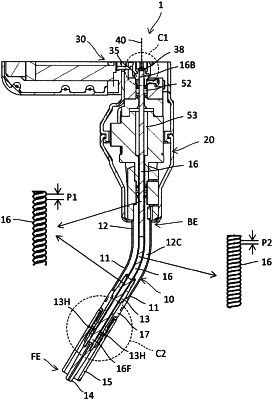| CPC B23K 9/133 (2013.01) [B23K 9/295 (2013.01)] | 3 Claims |

|
1. A welding torch, comprising:
an inner tube formed of a helically wound wire, the inner tube defining a passage for a welding wire;
a conduit in which the inner tube is inserted, the conduit having a curved portion;
a torch body including a tip portion and a nozzle arranged close to a forward end of the conduit;
a torch holder supporting a base end portion of the torch body and having a gas supply pipe for supplying a shield gas via a guiding conduit into a space between the inner tube and the conduit;
a wire feeder provided upstream of the torch holder to feed the welding wire forward to or backward from the inner tube; and
a seal for preventing a reverse flow of the shield gas to the feed unit;
wherein a gap is defined between adjacent wire segments of the helically wound wire of the inner tube allowing the shield gas to flow therethrough,
wherein wear debris generated by abrasion of the welding wire sliding in the inner tube can be ejected out from the nozzle through the gap,
wherein the conduit further comprises an upstream portion that extends upstream from the curved portion and a downstream portion that extends downstream from the curved portion, and
wherein the gap defined between the adjacent wire segments of the inner tube in a region that corresponds to the curved portion of the conduit is narrower than the gap in regions that correspond to the upstream and downstream portions of the conduit.
|